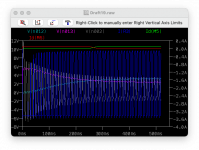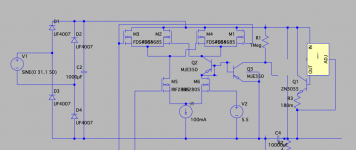I'm exploring the option to make a current limited soft start for floating linear supplies.
The supply is made up of a simple RC filter for high current (in this case about 3.1A) and about 24V. My approach is to have a small cap provide a base DC supply for a LM317 that is used for current limiting controlling a 30A capable NPN. Thus limits to about 3.6A but naturally the NPN would need bypassing to reduce power wastage and increase efficiency.
Todo this switch out I've cobbled together a differential Schmitt trigger out of mosfets. This detects the point that voltage of the output crosses a configured point. This works - you can see the currents crossing over 0-100mA and 100-0mA at the point of the cross over (red & green).

The issue I have is - getting the current output. I've tried both putting a mosfet buffer and both an NPN and PNP current mirror across but just don't get enough current to drive a switching mosfet/relay. This seems easier with tubes than solid state 😀 I'm probably missing simple stone cold simple..

Any suggestions?
The supply is made up of a simple RC filter for high current (in this case about 3.1A) and about 24V. My approach is to have a small cap provide a base DC supply for a LM317 that is used for current limiting controlling a 30A capable NPN. Thus limits to about 3.6A but naturally the NPN would need bypassing to reduce power wastage and increase efficiency.
Todo this switch out I've cobbled together a differential Schmitt trigger out of mosfets. This detects the point that voltage of the output crosses a configured point. This works - you can see the currents crossing over 0-100mA and 100-0mA at the point of the cross over (red & green).

The issue I have is - getting the current output. I've tried both putting a mosfet buffer and both an NPN and PNP current mirror across but just don't get enough current to drive a switching mosfet/relay. This seems easier with tubes than solid state 😀 I'm probably missing simple stone cold simple..

Any suggestions?
Last edited:
Doh.
A Standard mosfet opamp has a current mirror to cause the differential to output current when the input mosfet switches off.
Combining the Schmitt trigger into that same mechanism means the two sides are mutually exclusive, hence when it’s off there’s no current mirror driving the current out. Hence this is why the current always matches the current source and no current is left to output.
This is why the output buffers and voltage stage outputs failed. The output needs to take into account this effect.
A Standard mosfet opamp has a current mirror to cause the differential to output current when the input mosfet switches off.
Combining the Schmitt trigger into that same mechanism means the two sides are mutually exclusive, hence when it’s off there’s no current mirror driving the current out. Hence this is why the current always matches the current source and no current is left to output.
This is why the output buffers and voltage stage outputs failed. The output needs to take into account this effect.
Use a 36V rated voltage comparator IC to implement your Schmitt trigger. LM393 and LM311 are available in both thru-hole and surface mount packages, for example. They're specified to meet all datasheet parameters for any supply voltage between 5V and 36V. And since they're 40 years old, but still in active production, they are cheap jellybean parts.
I included an LM311 based Schmitt trigger as part of the "Dreadnought" and "Marauder" designs here on diyAudio -- and it worked beautifully. Supply was 34 volts.
I included an LM311 based Schmitt trigger as part of the "Dreadnought" and "Marauder" designs here on diyAudio -- and it worked beautifully. Supply was 34 volts.
Use a 36V rated voltage comparator IC to implement your Schmitt trigger. LM393 and LM311 are available in both thru-hole and surface mount packages, for example. They're specified to meet all datasheet parameters for any supply voltage between 5V and 36V. And since they're 40 years old, but still in active production, they are cheap jellybean parts.
I included an LM311 based Schmitt trigger as part of the "Dreadnought" and "Marauder" designs here on diyAudio -- and it worked beautifully. Supply was 34 volts.
Woo - thank you. I looked at op amps and missed these completely.